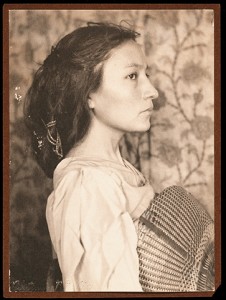Native American Heritage Month: Zitkála-Šá
Wednesday, November 1st, 2023
Zitkála-Šá, Indigenous American educator
Credit: Photograph by Gertrude Kasebier; Mina Turner, National Museum of American History/Smithsonian Institution
People in the United States observe Native American Heritage Month each year in November. During this period, many Native tribes celebrate their cultures, histories, and traditions. It is also a time to raise awareness of the challenges Indigenous people have faced in the past and today, along with their contributions to the United States as its first inhabitants.
As a storyteller, teacher, playwright, politician, and violinist, Zitkála-Šá fought every boundary placed before her. Zitkála-Šá, also known as Gertrude Simmons Bonnin, was a member of the Yankton Sioux or Yankton Dakota. Born in 1876, she became an influential leader in the United States, fighting for women’s rights, the Indigenous right to citizenship and voting, and the end to the Indigenous boarding school system.
When Zitkála-Šá was about eight years old, she left the Yankton reservation to attend White’s Manual Labor Institute in Wabash, Indiana. She was required to cut her long hair and any trace of her culture. She learned to read, write, and play the violin. Zitkála-Šá did not return home until 1887. She received a scholarship to Earlham College in Richmond, Indiana. Before she graduated, Zitkála-Šá began teaching music at Carlisle Indian Industrial School in Pennsylvania. A gifted musician, she studied violin at the New England Conservatory of Music in Boston, Massachusetts, in 1899. In 1900, Zitkála-Šá accepted an invitation to travel and play with the Carlisle school’s band across the United States and at the Paris Exposition, a world’s fair.
It wasn’t long until Zitkála-Šá started using her storytelling and writing skills against the Indigenous boarding school system that employed her. The Carlisle school sent Zitkála-Šá back to the Yankton Reservation in 1900 to gather more students. There, she found her community in poverty, with run-down houses and white settlers living on her people’s land. She returned to Carlisle and began writing about Indigenous life and culture. She translated Indigenous stories into English and Latin. She criticized the Indigenous American boarding school system in essays published in the magazines Atlantic Monthly and Harper’s Magazine. In 1901, she wrote the short story “The Soft-Hearted Sioux” about a student’s loss of identity and was fired from the Carlisle school.
She returned to the reservation and began writing stories for her collection of Sioux tales and legends, Old Indian Legends (1901), while working as a clerk for the Bureau of Indian Affairs (BIA) office at Standing Rock. In 1902, she married Captain Raymond Talesfase Bonnin. They moved to the Uintah and Ouray Reservation in Utah and had a son named Raymond Ohiya Bonnin in 1903.
Several years after moving to Utah, Zitkála-Šá picked up another medium. After befriending composer William F. Hanson, the pair wrote the first Indigenous American opera. Sun Dance (1913) was based on the then-outlawed Indigenous religious ceremony Sun dance.
After completing the play, Zitkála-Šá leaned more into her political work. She joined the Society of American Indians, which preserved Indigenous traditions while fighting for full U.S. citizenship. Zitkála-Šá lectured across the country about Indigenous culture and the right to be recognized as American citizens and to vote. Her American Indian Stories, a collection of essays on Indigenous treatment in America and in Christian boarding schools, was published in 1921.
Her efforts were partially rewarded when the Indian Citizenship Act passed in 1924. The act granted citizenship to Indigenous people, but poll taxes, literacy tests, and violence and intimidation were used to prevent many Indigenous people from voting. Of course, Zitkála-Šá and her husband continued to work for Indigenous rights and started the National Council of American Indians in 1926. She continued to work for the rights and cultural preservation of Indigenous people until her death. She died in Washington, D.C., on January 26, 1938. Zitkála-Šá is buried in Arlington National Cemetery.



